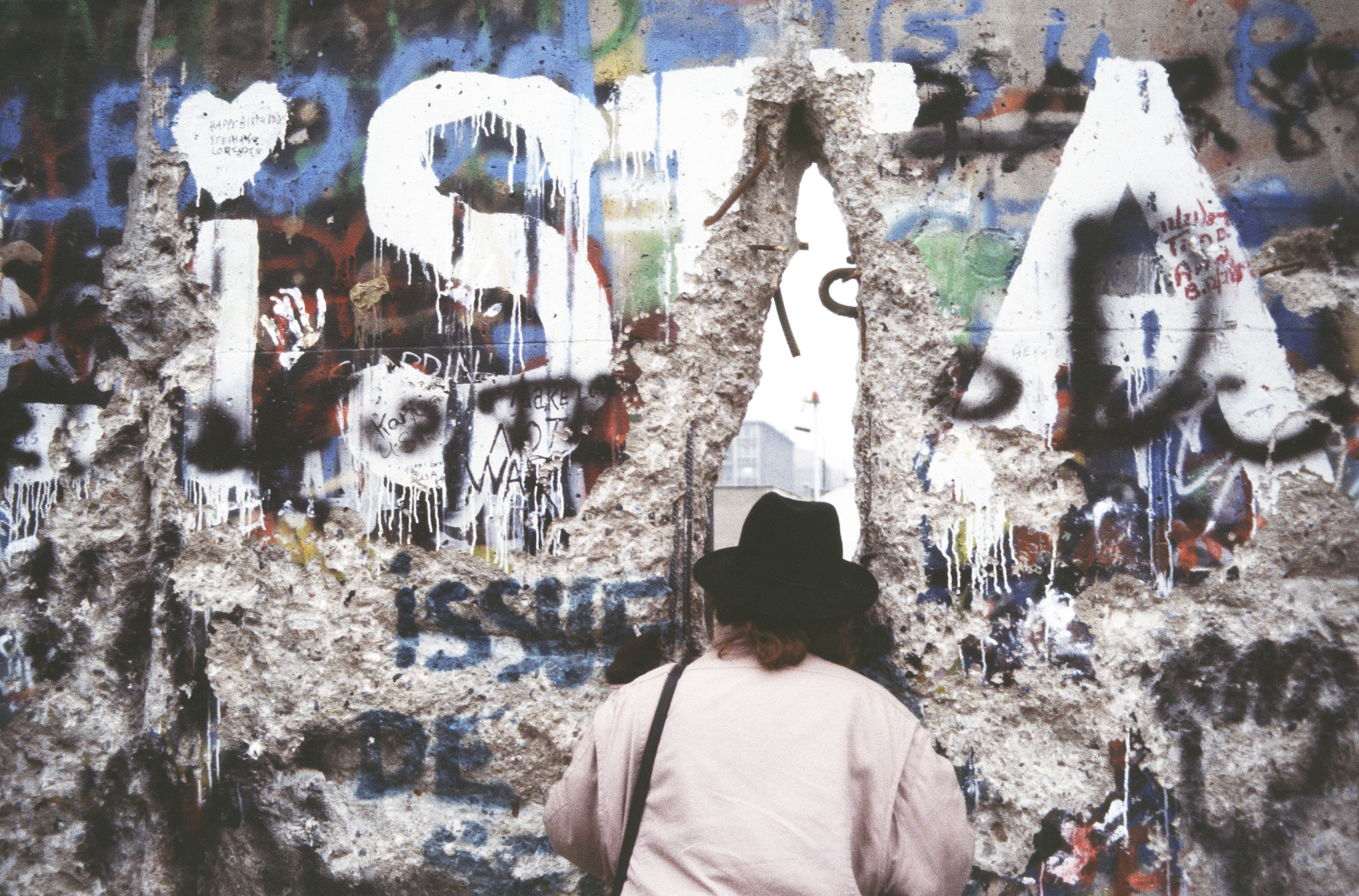On November 8, 1989, the Berlin Wall stretched over eighty-seven miles, surrounding West Berlin and separating it from its eastern counterpart just as it had for the past twenty-eight years. The next day, the East German (German Democratic Republic, or GDR) government announced that its citizens could freely visit both West Germany and West Berlin. A hundred thousand East Berliners lined up to cross the border, and in West Berlin people climbed the wall to celebrate and confirm its new irrelevance. Although official demolition of the wall would not begin until the next year, souvenir hunters began chipping away at it nearly immediately, and in the days following November 9, the GDR removed several sections to create new border crossings. Like the wall itself, the fall of the Berlin Wall was both metaphoric and literal.
Warren Breckman, a historian of Germany who was living in West Berlin at the time, says, “Berlin felt like an entirely new city the next day.” He remembers standing by a newly opened passage in the wall, watching the East Berliners freely cross into the West. “A journalist beside me called to a woman and her teenage daughter,” he recalls, “ ‘Where are you going to go?’ The woman responded, ‘Simply over there.’ ”
Between 1961 and 1989 the “Antifascist Protection Rampart” served as both physical barrier and symbol of the division and conflict that gripped much of the world in the wake of World War II. Of the 54,000 concrete slabs that once made up the western side of Berlin Wall, hundreds of these segments, often in pairs or groups, have made their way to far-flung locales. Separated into its constituent pieces, divided into fragments, the wall ceases to be an impediment and instead serves as a reminder of division and reunification, of conflict and resolution, of constraint and liberty. In each case, this potent symbol when removed to a different context absorbs new meaning from its adopted surroundings.1
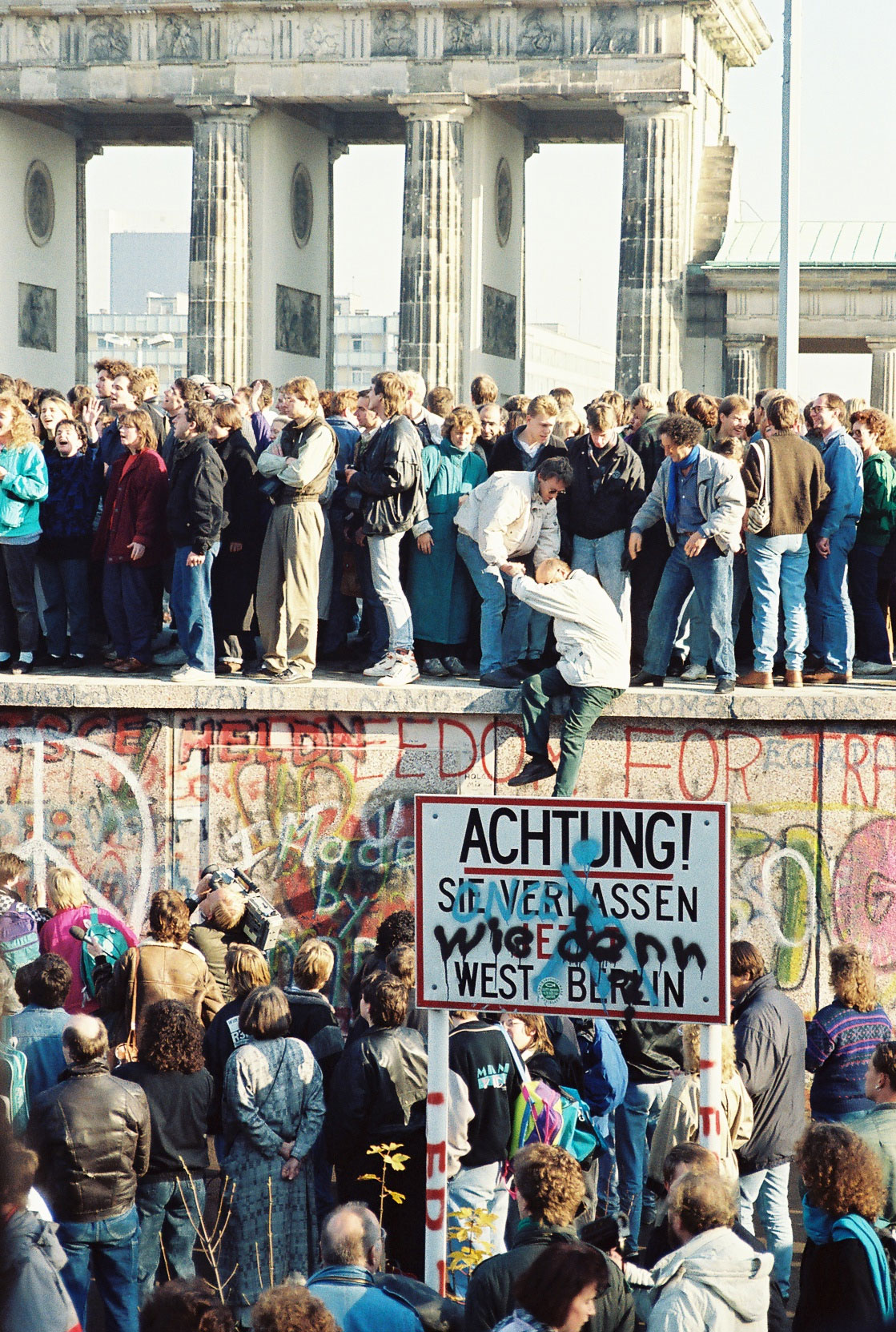
One fragment resides near the Sanctuary of Fátima in Cova da Iria, Portugal; another is on permanent display at the Mennonite Heritage Village in Steinbach, Manitoba; a third is at the Museum of the Philippines in Manila. Three segments can be found along the Cheonggyecheon Stream in Seoul, South Korea. At least 125 cities and towns around the world host more than six hundred expatriated segments; in several, like London, Washington, DC, and Grand Rapids, Michigan, visitors can spot the Berlin Wall at multiple sites.
That accounting includes only intact segments. Parts of the wall left Germany in more portable chunks, either gathered during its demolition or purchased in the years since at the souvenir shop at the Checkpoint Charlie Museum (a small piece is available on the museum webstore for €21.76; extra-large pieces go for as much as €179.90). Many of these purchasable pieces of the wall have been touched up with spray paint to look more like what people imagine the wall to look like—even if the untouched bits of concrete were closer to reality than their bedazzled brethren. Between memorials, museum collections, and souvenirs, there is more wall outside Berlin than inside it.
Some locations from Anna Kaminsky, ed., Where in the World Is the Berlin Wall, Leila Haddou’s interactive map in Philip Oltermann’s Guardian article “Where on Earth Is the Berlin Wall?” and The Wall Net.
But how did these pieces of wall migrate to their new homes?
Some were donated or gifted. Others were purchased directly. British troops who helped with wall demolition were granted permission to take segments home with them; these segments are now in British military museums. According to scholar Ronny Heidenreich, it only took a day for someone to express interest in buying a segment of the Berlin Wall; a Bavarian businessman wrote a letter to minister of foreign trade Gerhard Beil offering to purchase “unwanted sections of your border fortifications” on November 10, 1989. Offers and requests from British and American parties soon followed; some inquirers were interested in the historic and symbolic value of the wall and others in its monetary value as a commodity and an investment. The GDR government was initially reticent to sell off a proud symbol of its “antifascism” in a capitalist free-for-all, but by January 1990, strapped for cash, it authorized commercial sale of wall segments.
The Ministry of Foreign Trade granted the import-export company Limex an exclusive license to market and sell the segments of wall that had been removed to create border crossings, as well as other pieces Limex deemed especially valuable because of their location in the wall or for the art and graffiti that covered them. This arrangement limited availability and drove up prices. That year each 1.2-meter-wide segment of the wall was selling for between $60,000 and $200,000. People were primarily interested in the pieces from the Western side of the wall that were covered in graffiti and street art, and the GDR sent border guards to protect these in-demand segments from thieves and vandals. Limex and its partner, the West Berlin company LeLé Berlin, commissioned “anonymous” artists to decorate new segments of the wall and to touch up damaged graffiti in order to increase demand and therefore prices.
In another attempt to raise prices, several segments were sold at auctions—one in Berlin in April 1990 with disappointing results and another, much more successful auction in Monte Carlo, Monaco, in June, where seventy wall segments, some painted by artists working in West Berlin and others by “anonymous” artists, were sold. While exact revenue figures are unknown, reports suggest that the auction brought in between 1.8 and 2.2 million DM (or about $957,000 to $1.17 million). Although consumers seemed happy to buy segments painted after the wall had fallen, artists Thierry Noir and Kiddy Citny later sued Limex and LeLé for selling their wall art without their permission. (Limex claimed that the paintings were not art but “damage” to GDR property, but the court decided in favor of Noir and Citny.) Once demolition and disposal of the wall began, fragments could be purchased more informally and cheaply directly from the border guards and private companies tasked with its removal.
Most of the wall—the parts not adorned in art and therefore not desirable as commodities—ended up in roads and other public works projects. The value of wall fragments began to decline after reunification, and today the historical souvenirs don’t command quite as high a price as they did in mid-1990. In March 2019 two fragments of the wall, one four and one two segments wide, sold at auction for £12,000 and £5,000, respectively.
The Berlin government kept a stash of thirty wall segments to gift to countries on the occasion of state visits; as of five years ago, only three remained unclaimed.
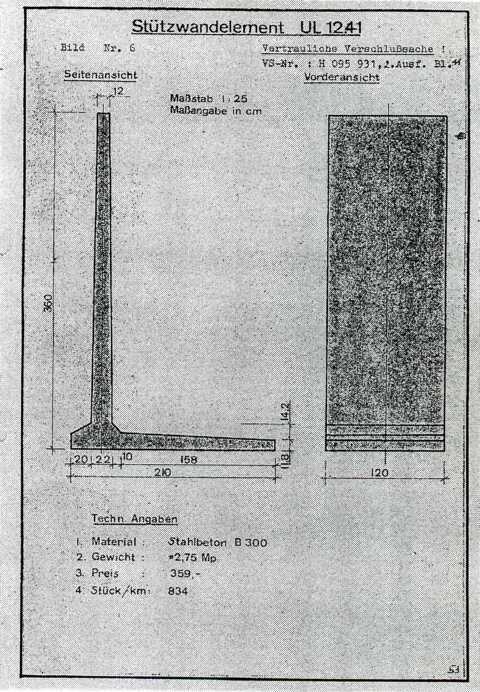
There are many limitations, both symbolic and real, to memorials nodding at unfreedom and freedom, consisting of the orphaned immigrant scraps of an Antifascist Protection Rampart. As Breckman notes, the individual segments belie the fact that there was not one wall, but two, separated by a no-man’s-land and surveilled by guard towers and machine guns. He says that when he comes across these transplanted fragments, divorced from their historical and physical context, “They actually look small and insignificant to me. Was the wall really not taller?” Freedom monuments made of Berlin Wall scraps rarely mention the at least 140 people who died at the wall. The breaks in the metaphor become especially clear in a world where we increasingly choose to build walls, both physical and legal, to constrain the movement of people across borders. In 2014, in anticipation of the twenty-fifth anniversary of November 9, a performance art group called the Center for Political Beauty stole fourteen white crosses from central Berlin—a memorial to those who were killed trying to escape the GDR over the Berlin Wall—and released pictures of the crosses affixed to European Union border fences. The group then announced plans to tear down part of Europe’s border fence during the twenty-fifth-anniversary celebrations, to protest the deaths of migrants trapped behind those fences.
Memorials around the world continue to draw on the symbolic value of Berlin Wall fragments, to call on its history as a thing that once stood and then fell down to tell stories of persistence and resistance. Here are the stories of some of those fragments.
(1) Winston Churchill Memorial and Library, Westminster College, Fulton, Missouri
Placed in 1990

Edwina Sandys carved two large human-shaped silhouettes out of eight graffitied panels of the Berlin Wall for her monumental sculpture Breakthrough, installed at Westminster College in Fulton, Missouri. Sandys also used the man- and woman-shaped cutouts from the work for her sculpture BreakFree, at the Franklin D. Roosevelt Library in Hyde Park, New York.
Sandys, who is Winston Churchill’s granddaughter, had long been interested in building a monumental sculpture on the site where her grandfather delivered his “Iron Curtain” speech in 1946. What better way to commemorate the metaphor that helped define the Cold War than with the pieces of concrete that made it literal? Hoping to secure wall pieces for her sculpture, Sandys traveled to Berlin in February 1990 only to be stopped short by the high prices the fragments were commanding. But Berlin officials, impressed with the monument’s concept and especially its planned location, donated eight wall segments. Sandys chose her fragments from a portion of wall near the Brandenburg Gate because of the graffiti drawn on the panels: words and shapes in bright red, yellow, and green; stark white and black; and the repeated word unwahr (“untrue”).
Ronald Reagan attended the official unveiling of Breakthrough on the one-year anniversary of the fall of the Berlin Wall. In his address he alluded to his 1987 speech in front of the wall in Berlin when he had called on Soviet leader Mikhail Gorbachev to “tear down this wall.” Two years later—forty-six years after Churchill declared that an iron curtain was falling across Europe—Gorbachev stood in front of Breakthrough and gave a speech that served as a symbolic close of the Cold War. The Soviet Union had collapsed, Gorbachev had stepped down as its leader, and he could reflect on the errors that had led to decades of hostility. In his speech, Gorbachev said of Breakthrough that “the sculptor’s imagination and fantasy, with remarkable expressiveness and laconism, convey the drama of the Cold War, the irrepressible human striving to penetrate the barriers of alienation and confrontation.”
(2) Vatican City Gardens, Vatican City
Placed in 1994
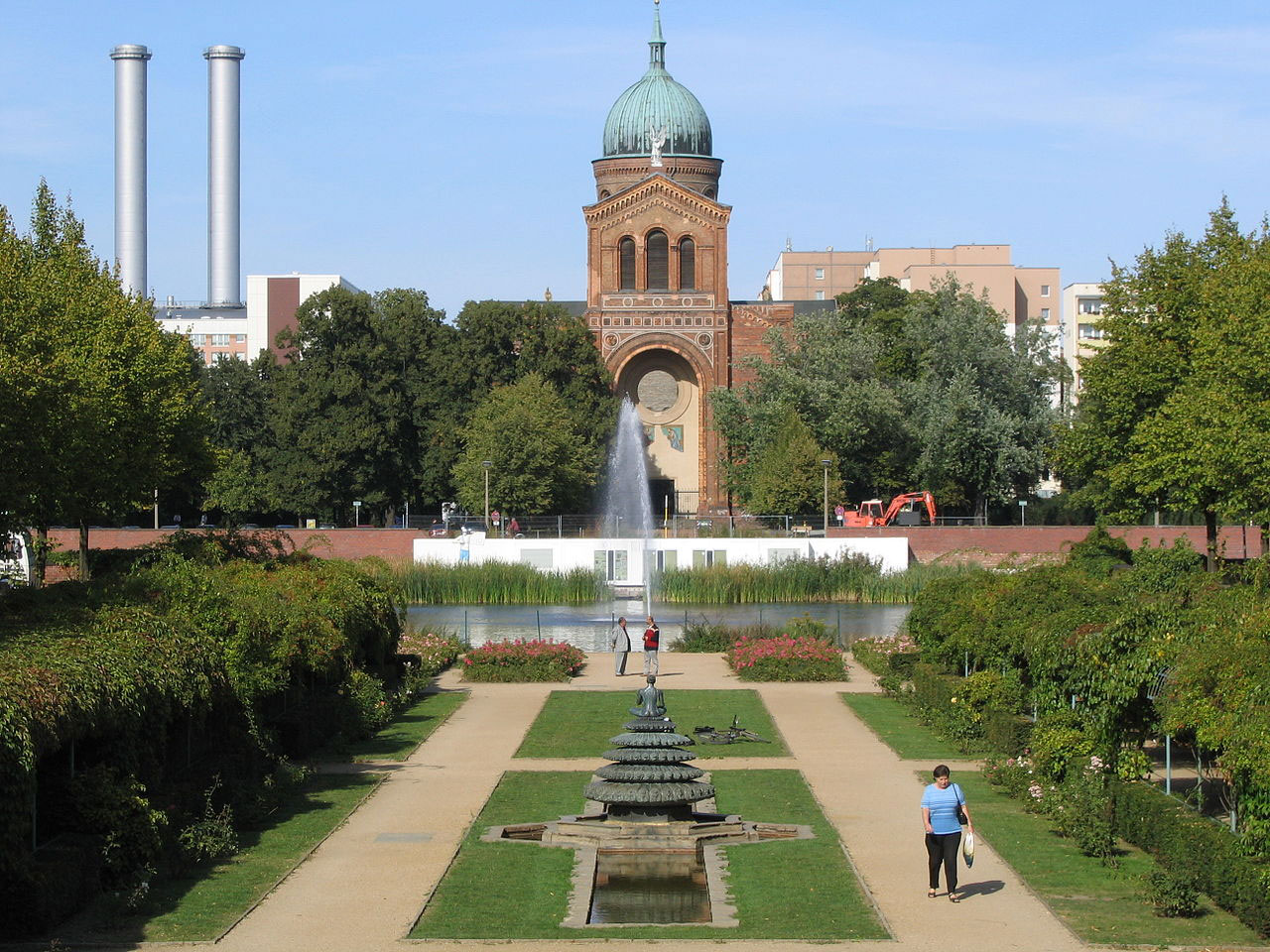
One segment of the Berlin Wall stands in the Vatican Gardens, alongside ornate sculptures, fountains, and elaborate plants and topiaries. The Italian businessman and politician Marco Piccininni originally purchased this segment at the wall auction held in Monaco in 1990 and donated it to the Vatican shortly thereafter. It found its current place in the garden and was officially dedicated in 1994.
The Vatican fragment is notable for its decoration: one panel of a larger painting of the bottom half of an East Berlin church. The erection of the Berlin Wall in 1961 divided the parish of St. Michael’s Church. Those in West Berlin, unable to cross the border to attend mass, were forced to build a new church and a new parish. The wall also obscured the bottom half of the church from West Berliners, who were used to seeing the building in full from the Luisenstadt Canal. In 1986 the architect Bernhard Strecker asked the artist Yadegar Asisi to create a trompe l’oeil panting on the wall, to make it seem as though the whole church could be seen from the West. The Vatican Garden fragment serves as a reminder that the political decisions that led to the division of Berlin also created divisions within the Catholic Church. The two parishes remain separate to this day.
In 2014 the Vatican issued 94,000 commemorative coins on the occasion of the twenty-fifth anniversary of the wall’s fall.
(3) Kalijodo Park, Jakarta, Indonesia
Placed in 2017
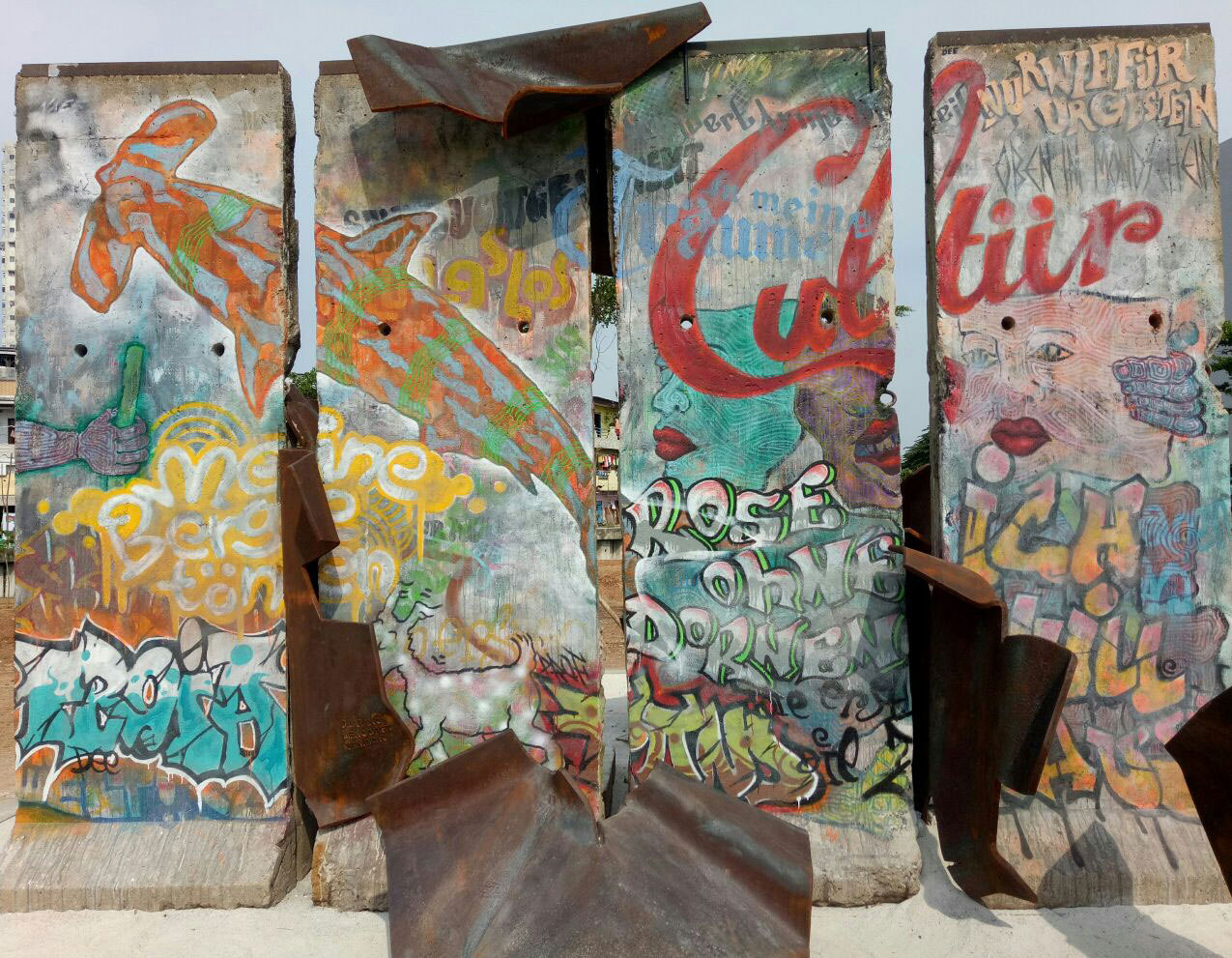
In a park in Jakarta, four segments of the Berlin Wall, covered in colorful paintings—including a small white dog, a psychedelic hammerhead shark, and the word cultür in Coca-Cola script—form part of a sculpture called Patung Menembus Batas (Transcending Limits) by artist Teguh Ostenrik. Around the four pieces of the wall, large human-shaped sheets of metal are poised in the act of stumbling toward, slipping between, and climbing over the panels, twisting sideways and bending around corners. Ostenrik has said that the figures represent “the people longing for freedom despite the obstacles they face.” Their bending suggests resiliency and flexibility, and the steel they are made of represents the strength of human will. Ostenrik donated the piece to the city, hoping it will remind those who view it of the importance of maintaining unity despite our differences.
Ostenrik had the panels for years before they became part of this sculpture; he bought them from Limex in 1990 and kept them in his studio in Depok. He had long planned to create a sculpture from the fragments, but his plans to install it in Jakarta, first in Fatahillah Square and later in a never-realized development to be named Berlin Square, met with complications and delays from Jakarta’s authorities, in part due to financial constraints. Kalijodo was Jakarta’s largest red-light district until 2016, when it was razed, evicting thousands of sex workers—a decision that prompted significant controversy. It was rebuilt as an urban park in early 2017. Ostenrik told the Indonesian newspaper Kompas that he had been inspired to build his memorial on ground that once had been unsafe for many but was now open to everyone. The article noted that one of Ostenrik’s close friends, Yori Antar, was an architect on the park development, which may explain how Ostenrik was finally able to erect his monument in public.
(4) Editorial Perfil building, Buenos Aires, Argentina
Placed in 1992
The eight segments housed inside the front entrance of the publishing company Editorial Perfil in Buenos Aires, Argentina, represent one of the largest expanses of the Berlin Wall outside of Germany. The pieces originally arrived as part of a twenty-meter-long portion of the wall in 1992 that was used in the city’s celebration of the four-hundredth anniversary of Christopher Columbus’ voyage across the Atlantic, alongside replicas of the Santa Maria and a Mayan village and pavilions from countries in the Americas. The Berlin Wall exhibit, sponsored by Perfil, had images of divided Berlin posted on the wall and a place where visitors could attempt to “escape” through a tunnel under the watchful eye of mannequin border guards, all set to the soundtrack of Richard Wagner’s Tannhäuser.
On its website, Perfil explains that it wanted segments of the wall because its newsmagazine had closed its first issue on the day the wall came down—the connection forged by this coincidence felt too special not to commemorate. In response to inquiries about acquiring a portion of the wall, the GDR reportedly told Perfil it could have segments in exchange for donations to construct a school in Germany. Perfil cofounder Jorge Fontevecchia wrote that the fragment “reminds us each day as we enter our newsroom that, as journalists, we must tear down not only exterior walls but also internal ones.”
(5) Andrey Sakharov Center, Moscow, Russia
Placed in 1996
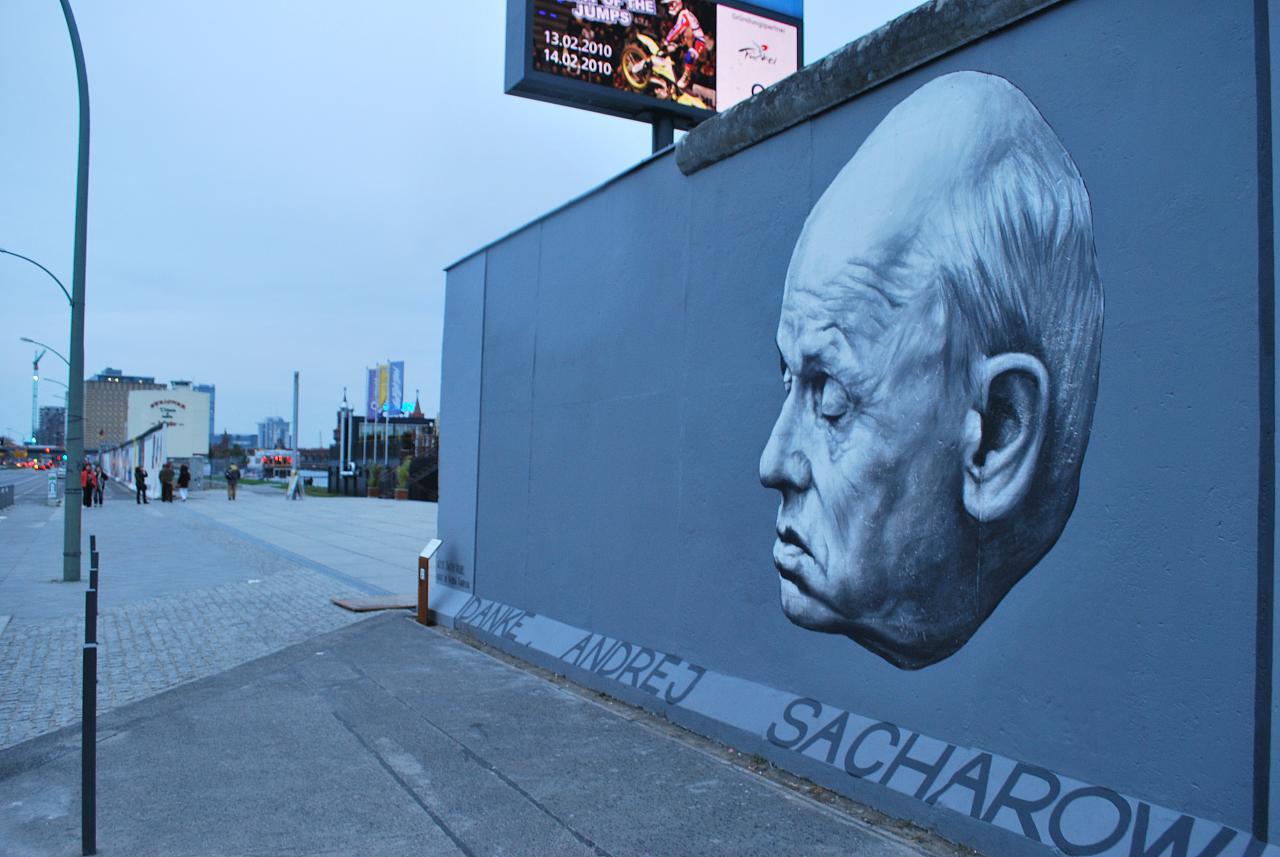
Very few segments of the Berlin Wall stand in the open and available for public perusal in Russia. One piece, erected in a park on the Yauza River in Moscow, has a hole carved through it and is decorated with large colorful three-dimensional butterfly sculptures. The fragment sits on iron bars that hold it at an unstable-looking angle, in front of a center named for the physicist and human rights activist Andrey Sakharov, who helped found the civil rights organization Memorial, which seeks redress for Stalinist crimes and works to publicize Soviet atrocities. The Sakharov Center was founded after his death in 1989 in order to continue his work and preserve his legacy.
After earlier attempts to secure a wall fragment for Moscow had fallen apart, this fragment was donated to the Sakharov Center by the Checkpoint Charlie Museum and installed in 1996. Artists turned the bare concrete into a memorial to freedom by creating the hole and adding the butterflies, symbolizing victory over the seemingly impenetrable Iron Curtain. Sakharov Center curator Natalya Samover has said that the wall sculpture “is a representation of the exceptional beauty of freedom.” Most of the other sculptures on the grounds were built from repurposed weapons or other military waste.
(6) St. George’s Mall, Cape Town, South Africa
Placed in 1996
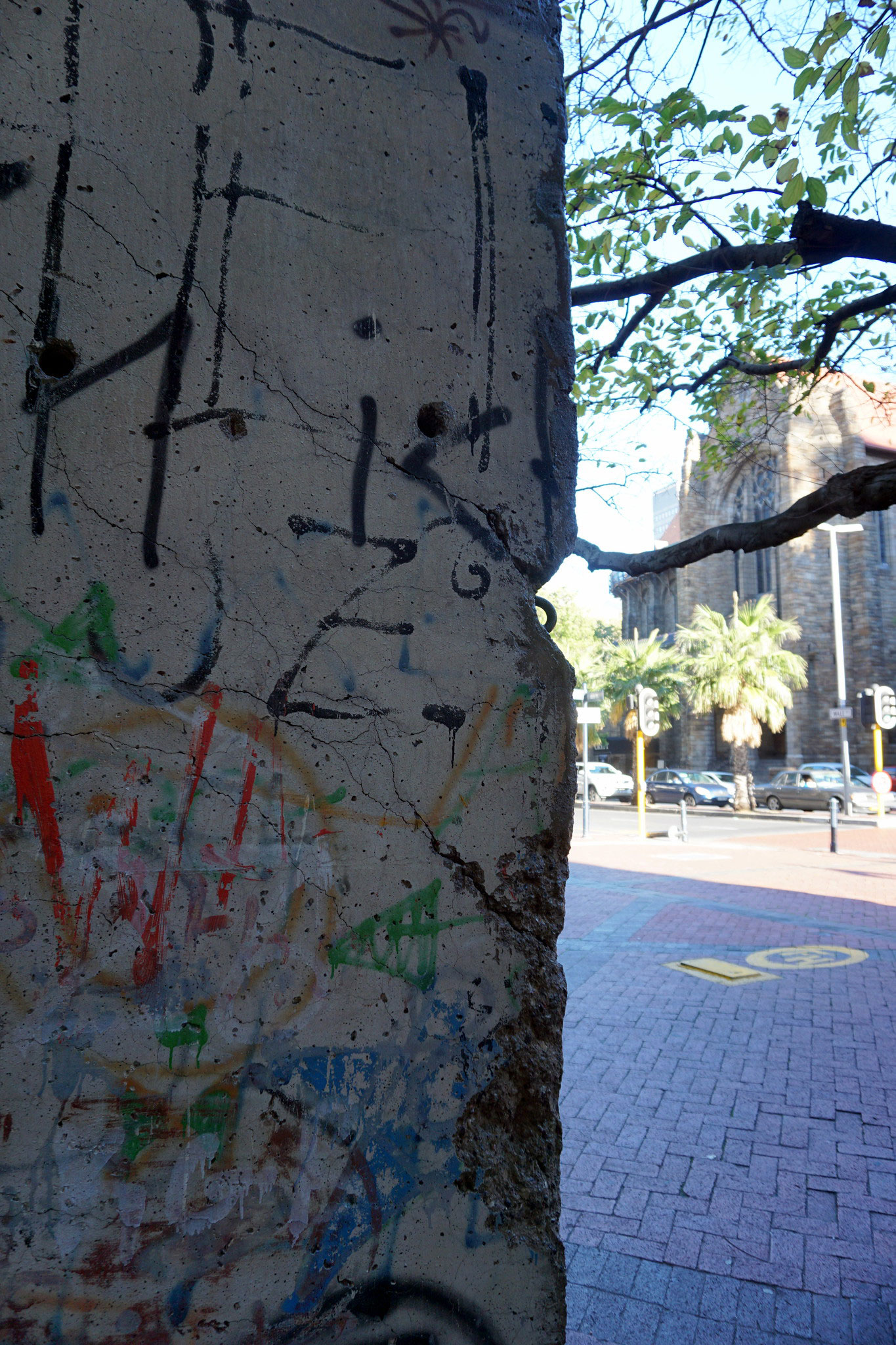
Cape Town’s Berlin Wall fragment was gifted to Nelson Mandela on a state visit to Berlin in 1996. It originally stood outside the BMW Pavilion at the waterfront but now can be found outside the Mandela Rhodes Foundation on St. George’s Mall. Mandela and Dr. Uwe Kästner, then the German ambassador to South Africa, selected the segment personally.
After the GDR decided to open up travel between East and West Germany and the Berlin Wall fell, the South African government moved to decriminalize anti-apartheid movements, the first in a series of steps that would eventually lead to the end of apartheid. Then-president F.W. de Klerk said that the weakening of global communism represented first by the fall of the wall and then the collapse of the Soviet Union at the end of 1991 made it politically possible to offer concessions to and to negotiate with the socialist African National Congress. Mandela was released from prison in February 1990, and became president in 1994.
Mandela’s connection to the Berlin Wall is also preserved elsewhere. In 2014 muralist Kent Twitchell added Mandela’s portrait to the ten-panel wall fragment installed across the street from the Los Angeles County Museum of Art in California.
(7) Various locations, Grand Rapids, Michigan
Placed in 1991–94
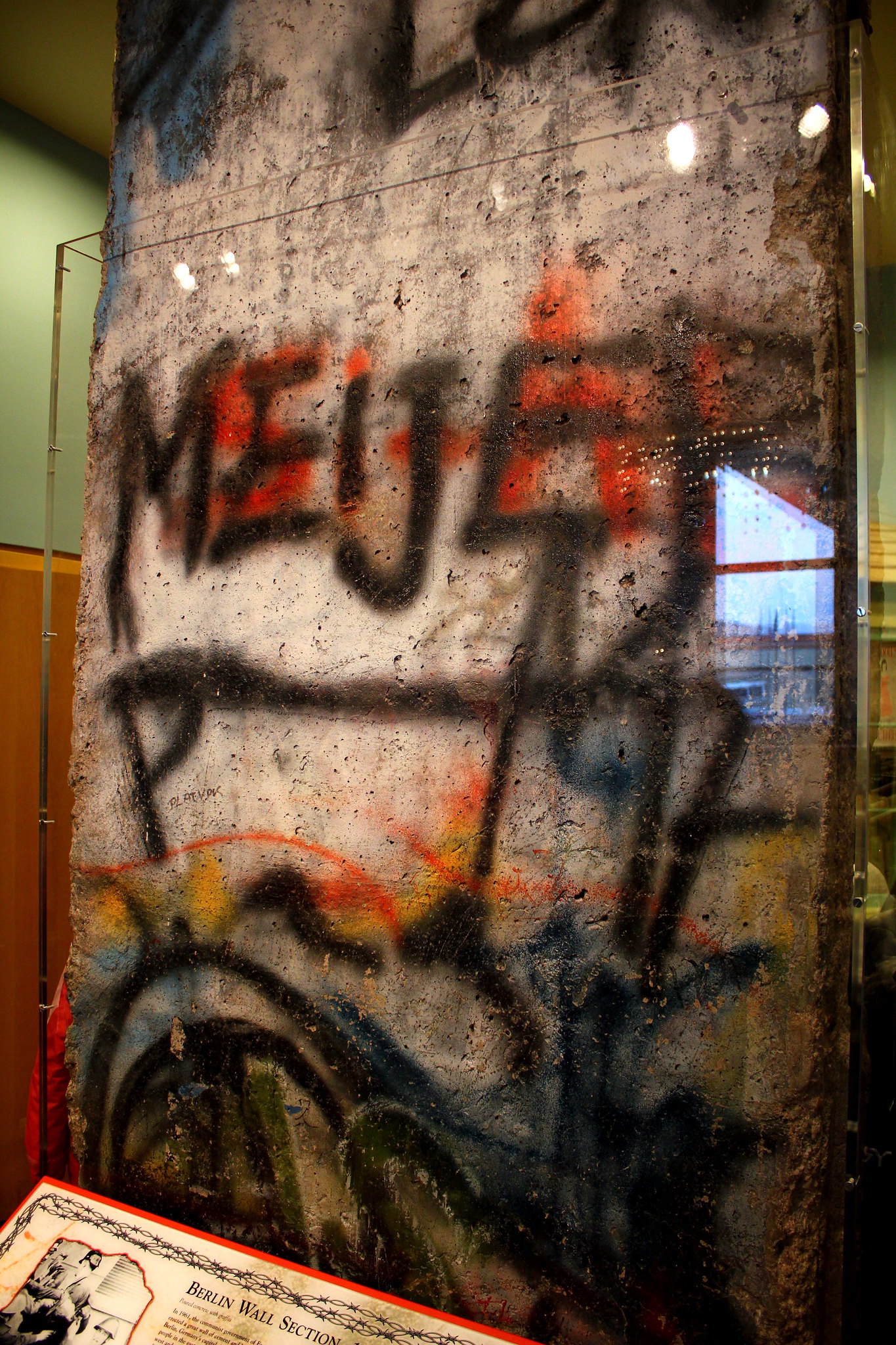
Grand Rapids, Michigan, is home to three separate fragments of the Berlin Wall. All three fragments—one at the Grand Rapids Public Museum, one outside the Mary Idema Pew Library at Grand Valley State University, and one at the Gerald R. Ford Presidential Museum—were originally purchased by the billionaire supermarket tycoon Fred Meijer, called a pioneer of one-stop shopping by Forbes. According to scholar Anna Kaminsky, editor of Where in the World Is the Berlin Wall?, Meijer was first inspired to purchase the fragments In November 1989 after seeing a photograph in the London Times showing a still-standing piece of the Berlin Wall, graffitied with the word Meijer. He bought that piece and two others from the Berlin Wall Commemorative Group, Limex’s affiliate in the United States. The Meijer segment stands in the Van Andel Museum, where it has been on display since 1994. The Grand Valley State fragment, once adorned with spray paint that seems to have worn away with time, was dedicated in 1992 with a plaque that reads may this wall remind us all of the precious gift of freedom which we possess and which all humans desire. The piece donated to the Ford Museum in 1991 stands in the Meijer Lobby. Meijer was a friend and supporter of Ford’s, and in a 2008 interview he said he had acquired the piece of the Berlin Wall for Ford’s museum because “I got to like him very much.”
1 The wall’s presence is still felt in Berlin even in its absence and relocation. Cobblestones mark the path it once traced through the city. Several fragments of the wall, made up of 1.2-meter-wide concrete segments, remain in place, calling attention to the empty space beside them. Calls to preserve or memorialize parts of the wall came immediately after the fall. The largest preserved segment of the wall, the East Side Gallery, is a 0.8-mile-long (1.3 kilometers) open-air art gallery of murals, many of which are in need of restoration and preservation. A memorial on Bernauer Strasse, completed in 1998, attempts to give a sense of the wall as it would have been experienced: it preserves a portion of both western and eastern walls, the “death strip” between them, and a guard tower. The Berlin Wall Trail, completed in 2006, covers not only the wall that divided West and East Berlin but also the border fortifications that divided West Berlin from the rest of East Germany.↩
